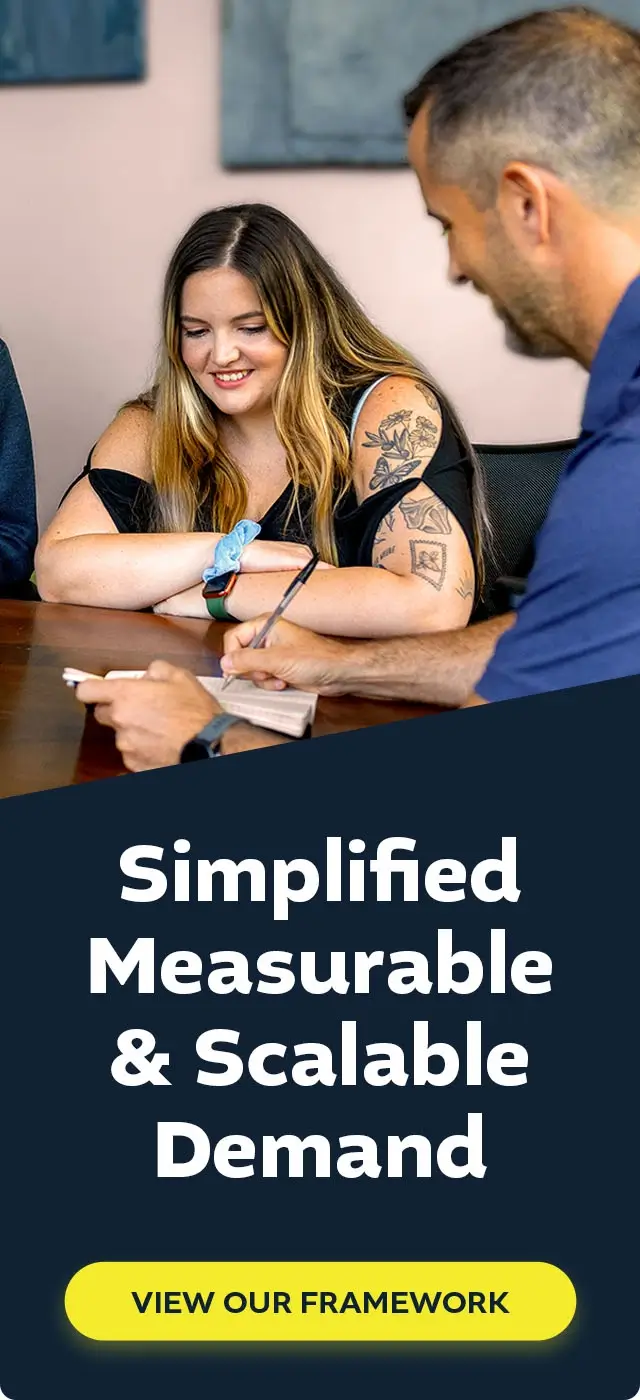Once you’ve got a great website that’s connected to your Web 2.0 properties, analytics tools, you should be set… right?
If not, read our blog on creating your digital marketing foundation.
Unfortunately, the phrase “if you build it, they will come” doesn’t necessarily apply. So then how do you actually drive demand?
There are several ways to generate demand. You can utilize organic and paid channels online and offline. In the digital space; the main two methods of generating demand are through paid media, like ads, and organic traffic from search engines and Web 2.0 properties.
You can also watch our video, where I cover the content of the blog and throw in some use cases to clarify some of our points!
Paid Media Channels
As part of your digital marketing foundation, you should have spent some time getting a better understanding of your target market. Who they are, what they like, and most importantly — where they spend their time online. While it’s not a perfect science, you can make some inferences about your target audiences based on their demographics and behaviors. For example:
- Targeting young moms? They likely spend a lot of time on Facebook, and Pinterest, and probably search for answers to their questions and problems on Google.
- Targeting older generations? It’s likely they’re not entirely computer savvy, but enjoy staying connected. In these cases, Facebook and Bing ads (Microsoft’s default search engine for its browsers) may be your best bet.
- Targeting business decision makers? LinkedIn and Google are good options, as well as less traditional paid advertisements on sites frequented by business professionals, like G2Crowds or Capterra if you’re a SaaS.
Sometimes your assumptions will be wrong, and that’s okay. Demand Generation is a constant process of learning, optimizing, and testing new hypotheses, even when things are going well.
There are countless digital advertising platforms, but some of our favorites are the classics: search engines and social media.
Search Engine Marketing
Search Engine Marketing (SEM), often called Pay-per-Click (PPC), is a great ad platform for nearly every company. People are always searching for solutions to problems, and looking for it on the internet has become almost second nature to most of us.
The most commonly known search engine is Google, but Bing and Yahoo are also frequently used search engines. All three feature paid ads that are delivered to users based on their search queries.
Running successful search engine ad campaigns takes time and money. Depending on your industry, you may spend thousands of dollars in your first month with little to no return. The ad spend isn’t a waste, however. It’s important to understand that while there is money being spent, there’s a lot that can be learned from the data, even if it’s as simple as “this isn’t working.” It informs you that something needs to change.
There are a few things we focus on here at OM:
- Most importantly, we want to find our high performing keywords as quickly as possible.
- To do this, we keep our initial target keyword list small, but with several broad terms so we can find new high-performing “money keywords” and quickly scale up.
- Search impression share is key — you want to have as close to 100% search impression share as possible. When your ads capture 100% of search impressions, you’ll beat your competitors far more often.
- We track our Google Ads conversions by importing our goals from Google Analytics. It will work differently for other search engines, but this is best practice for Google Ads.
There’s a lot more that goes into search engine marketing, which we’ll cover in a later blog.
Social Media Marketing
Running ads on social media is very different from running ads on a search engine. For simplicity’s sake, I’ll be talking about Facebook (this includes Instagram by proxy) and LinkedIn. There are several other advertising platforms that have their own merits, which I’ll cover later.
Paid social media marketing can go hand in hand with your organic efforts, and strategy is key here. The difference between a generic ad campaign and a strategic, layered blend of ad campaigns with different objectives is staggering.
What’s the best way to plan your incredible, wonderful custom-blended ad strategy? Funnel your social audiences first. Picture your target audiences as a funnel:
- People who are completely unaware of your offering are outside of the funnel.
- People who know about your offering but aren’t quite ready, or don’t know enough about it are at the top.
- People who know about your brand or are learning more about your offering are in the middle.
- People who are in the final stages of the buying cycle, comparing their options and really looking at your brand are at the bottom.
- People who have completed your desired action have made it through the funnel in its entirety, and may be back to the middle or bottom if there is an opportunity to remarket.

Once you understand the stages of your funnel, you’ll want to build out campaigns and audiences to capture them.
Top of Funnel
For Top of Funnel (TOFU) audiences, we typically create a couple of campaigns with different objectives. This depends largely on the company and how well known it is, but we’ll choose between Awareness, Traffic, and Conversion objectives for TOFU audiences. TOFU audiences usually consist of saved audiences using Facebook’s native targeting options. If the company has enough historic data, we’ll also create lookalike audiences using website traffic and converters.
Middle of Funnel
Audiences in the Middle of the Funnel (MOFU) tend to be similar, with less focus on traffic and awareness and more on conversions. MOFU audiences can be served ads with a higher intent, such as purchasing or signing up for a demo, rather than lower-barrier tactics like ebooks or discounts.
Bottom of Funnel
Bottom of Funnel (BOFU) audiences have often already been to your site, have purchased from you in the past, or are incredibly similar to your current customers. BOFU audiences are the closest to purchasing from you (or have purchased from you recently, so be careful about this). These are the people who may need the teeniest nudge to get them to convert. They tend to be cheaper than TOFU or MOFU conversions, even though conversion campaigns are more expensive than other campaigns.
Almost as important as identifying your target audiences on social media is running ads on the platforms they frequent. You’re not going to find a lot of lawyers on Pinterest, but you’ll almost always find them on LinkedIn. Conducting research, and often just using common sense, to meet your audience where they’re at is key to running a successful social media campaign.
A few viable, but less “traditional” social media platforms to consider:
- Snapchat
- Spotify
There are several more, but each of these platforms has its niches, and you should consider adding them to your advertising strategy if you have the resources. Remember; you’re trying to connect with your target audience so keep an open mind to different platforms.
Search Engine Optimization
The final major piece of demand generation is SEO. Organic traffic is free, but the work that goes into it isn’t. SEO takes time, at the very least, and often costs quite a bit of money. Depending on your strategy, you, an employee, or a freelancer may be writing copy for your blog or website. Over time, with a focused SEO strategy, you may begin to see improvements in your keyword and overall site rankings.
In your foundation, you should have identified your target keywords. Think about your target audience. What content is valuable to them, and how can you incorporate your target keywords? Search engines want to provide valuable, satisfying, and relevant search results, so they reward websites that provide content that is valuable to their users with top positions.
One strategy we employ is content webbing. We’ll create one long-form piece with a good amount of information, then create smaller pieces that go further into detail. We link these internally so that users can learn more, and so that search engine crawlers can see that there is more information available.
As time goes on you can identify opportunities and tailor your strategy to go after them and hone in on your winners, but an initial strategy is key to SEO.
Demand Generation should always come after you’ve laid out a strong, scalable foundation. The work you did getting everything set up will allow you to see if your demand generation strategies are working, or if you need to shift gears. This goes for every platform. Be sure to follow the directions given to you by each advertising platform, because no two are exactly alike, and they often need their own tracking codes installed on your site.
Once you’ve successfully implemented your demand generation strategy, you can begin optimizing (the gear shifting, if you will). Some of your strategies won’t work out, and that’s fine. What’s important is to give your strategy time (and money) to perform, then kill the poor performers and feed into your winners.
Not really keen on doing all of this for your own company? Lucky for you, we’re a digital marketing agency. Set up a time to talk and let’s see if we’re a good fit for your business.


